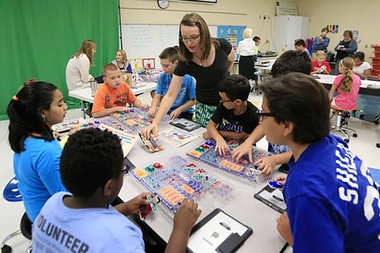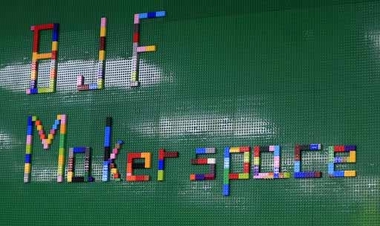'Makerspaces' balance, challenge for test-heavy curriculums

Shawnee, Kan. — Fifth-grader Bella Bartlomi sits at a table full of circuits and small robots, trying to connect the right circuits to make a small wheel spin. Instructors are standing by in the room, called a "makerspace," but let the students at the suburban Kansas City elementary school figure out things by themselves.
Eventually, she finds the right combination, showing off the spinning wheel with a big smile. "It makes me feel smart," she said. "I made it work. I tried to figure out how to make this move and I did it, by myself."
The "maker movement" that's reached K-12 schools across the United States during the last two or three years encourages collaborative, creative, student-driven education, and many educators have enthusiastically embraced the move away from the traditional classroom, in which teachers are "the sage on the stage" dispensing information.

But there are concerns that already-busy teachers will have trouble incorporating a counterpoint to schools' increasingly test-based curriculums that emphasize reading, writing and arithmetic. Plus, some of the makerspaces are being instituted in school libraries, where the quiet, reading-oriented space can be disrupted by the sometimes noisy creation process.
The Shawnee Mission, Kansas School District, where Bella's Bluejacket-Flint Elementary is located, is converting rooms at several schools to makerspaces. The room where Bella recently worked houses a wide range of materials, including a 3-D printer, building blocks, a sewing machine and baskets of old toilet paper rolls, yarn and buttons.
"When you give kids the opportunity to work with their hands, and to go and show it from start to finish, they become so engaged, that they can talk with passion about it," said Christy Ziegler, the district's assistant superintendent for curriculum, instruction and assessment. "The days of standing up and rote reporting because it was assigned to me is changing."
It's difficult to quantify the maker movement's growth nationwide because research on such spaces in schools has barely begun, said Stephanie Chang, director of programs for the Oakland, California-based Maker Education Initiative. She noted her nonprofit has "been busier each year (since the group started in 2012)."
The transition for teachers from lecturing and testing to facilitating students' self-discovery can be daunting, because they must also meet curriculum and educational mandates, such as the multi-state Common Core and Next Generation Science requirements. Plus, most states have significantly changed how teachers are evaluated since 2009, with test scores are becoming a more important component, according to the Center of Public Education. Forty-one states require or recommend that teachers be evaluated not only on test scores but on other measures, such as observations of their classes.
Chang said her organization constantly gets questions about whether students will do well on tests if instructional time is devoted to maker education. Data isn't available yet to answer that question but she said teachers can "absolutely" use makerspaces to integrate content required for testing while also developing "hard skills," such as hammering or computer coding, and "soft skills," such critical thinking and collaboration.
"Coupled together, that makes for a more holistic learner as opposed to memorizing and regurgitating facts," she said.
Heather Moorefield-Lang, an assistant professor with the School of Library and Information Science at the University of South Carolina, notes that makerspaces "aren't for everybody."
"I tell folks all the time that you have to look at the school's culture, at the community, and ask 'Is this the approach for your faculty, your staff, your community?' These places don't work if there is no buy-in," she said, adding that there is little formal training for the maker movement.
The American Association of School Libraries is concerned about reports of some schools replacing credentialed librarians with innovation specialists who are not certified in library sciences, according to president Audrey Church. But she stressed the organization strongly supports the movement.
"As librarians, our mission is to help students become critical thinkers, enthusiastic readers, skillful researchers and ethical users of information," she said. "Certainly, makerspaces fit really well within both the association and the mission of librarians."
Angela Rosheim created a makerspace at the library at Lewis & Clark Elementary School in Liberty, Missouri, about three years ago. The teacher-librarian said she and the district overall work hard to maintain a balance between traditional and makerspace education. She emphasizes reading, taking notes, using citations and being responsible users of information, supplementing those lessons with maker projects.
"Keeping with my curriculum hasn't been a problem for me," she said. "It does require some research, some trial-and-error and a lot of flexibility. But I figure out a way to make it gel so it works for me and my kids."
Margaret Stafford,
Associated Press
Copyright 2016 The Associated Press. All rights reserved. This material may not be published, broadcast, rewritten or redistributed.
Copyright 2016 The Gayly - 9/3/2016 @ 10:20 a.m. CDT.





